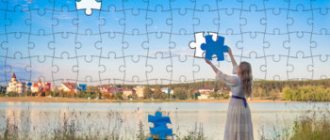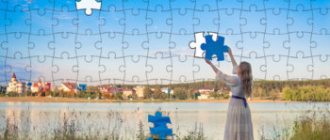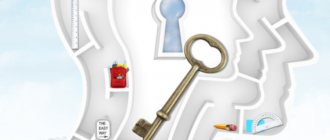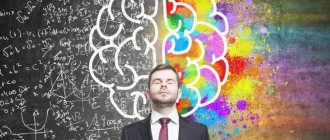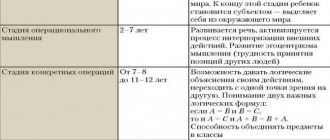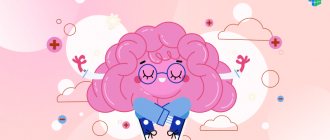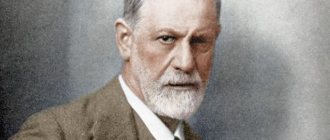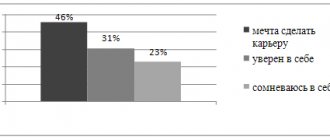Imagination as a mental process
Oksana Prokopenko
Imagination as a mental process
From this article you can learn about the functions and types of imagination. Children make many discoveries and create an interesting, sometimes original product in the form of a drawing, design, poem, etc. (E. A. Florina, G. V. Labunskaya, M. P. Sakulina, K. I. Chukovsky, J. Rodari, N. A. Vetlugina, N. N. Poddyakov, etc.). The novelty of discoveries and products is subjective; this is the first important feature of children's creativity.
At the same time, the process of creating a product for a preschooler is almost of paramount importance. The child’s activity is characterized by great emotional involvement, the desire to seek and try different solutions many times, receiving special pleasure from this, sometimes much more than from achieving the final result (A. V. Zaporozhets, N. N. Poddyakov, L. A. Paramonova, O. A. Christ and others). And this is the second feature of children's creativity.
The basis of creativity is imagination.
In the formation of creativity, a special role is given to the imagination (L. S. Vygotsky, E. V. Ilyenkov, V. V. Davydov, O. M. Dyachenko, V. T. Kudryavtsev, etc.). It is the developed creative imagination that gives rise to new images that form the basis of creativity.
Imagination is the mental process of creating new images based on past perceptions. It arose and developed in the process of labor, based on the need to change certain objects, to imagine something that a person did not directly perceive and does not perceive.
In other words, imagination is a special form of the human psyche, standing apart from other mental processes and at the same time occupying an intermediate position between perception, thinking and memory (characteristic only for humans).
Imagination is based on the transformation and creative combination of existing ideas, impressions and knowledge. The most fantastic fiction always consists of elements taken from life, from past experience. According to I.M. Sechenov: “Throughout a person’s head throughout his entire life, not a single thought passes that is not created from elements registered in memory. Even the so-called new thoughts that underlie scientific discoveries are no exception to this rule.” Imagination uniquely reflects reality. It is conditioned by life.
Functions of the imagination
The human mind cannot be in an inactive state, which is why people dream so much. The human brain continues to function even when new information does not enter it, when it does not solve any problems. It is at this time that the imagination begins to work. It has been established that a person, at will, is not able to stop the flow of thoughts, stop the imagination.
- Gnostic function. Imagination actively contributes to cognition (for example, in order to understand an unknown phenomenon one has to imagine it); the image created by the imagination facilitates the process of assimilation, especially with the participation of imaginative thinking.
— Prognostic function. Imagination allows you to see. replay an episode, a situation in your consciousness, correct its details.
— Educational function. It occurs during the deliberate creation at the level of fantasy and the subsequent implementation of certain human qualities.
— Protective function. A person uses a compensatory mechanism of the psyche, imagining himself in a quality that he lacks in reality: strong, resourceful, successful (A child in a game imagines himself as a leader when the sociometric level in the class is low)
— Communication function. Any creative product is always addressed to other people. (When writing a book, a writer always focuses on potential readers, even if it will not be published).
Types of imagination
1. Active imagination is aimed at transforming the surrounding reality:
a) recreating. The basis for creating images that match the description
b) creative. Independent creation of new images that are realized in ordinary and holistic actions. There is always a great emotional release.
2. Passive. Images that are not embodied in life are divided into:
a) unintentional (with a weakening of the role that controls consciousness - sleep-dreams, hallucination, state of passion)
b) intentional, but not dreams, with volitional effort.
and:
Affective imagination
It arises in situations when contradictions arise between the images that the child has formed in his head and the very reality that surrounds him. When a child cannot resolve these contradictions, his internal tension, anxiety and fear grow. Proof of this is the large number of fears in three-year-old children. It is worth noting that children resolve many contradictions on their own. And the affective imagination helps them with this. In this regard, we can safely say that the main function of effective imagination is protective, which helps the child overcome internal contradictions. Effective imagination also performs a regulatory function during the child’s assimilation of behavioral norms. The development of affective imagination is carried out through the child’s playback of experiences. They are mainly associated with experiences of fear. And if parents organize such games at home, they help eliminate fear.
Cognitive imagination
Along with affective imagination, cognitive imagination also stands out, which not only helps the child overcome emerging contradictions, but also complete and clarify a holistic picture of the world. With the help of cognitive imagination, children master patterns and meanings, build holistic images of events and phenomena. The development of cognitive imagination is carried out by the child while playing with toys.
Development of creative imagination
The imagination of a preschooler differs from the imagination of an adult; behind its apparent wealth lies poverty, vagueness, sketchiness and stereotyping of images
.Features of imagination development in preschool age:
imagination takes on an arbitrary character, presupposing the creation of a plan, its planning and implementation;
it becomes a special activity, turning into fantasy;
the child masters the techniques and means of creating images;
imagination moves to the internal plane, there is no need for visual support for creating images.
A preschooler does not create anything fundamentally new from the point of view of social culture. The characterization of the novelty of images matters only for the child himself: whether this was the case in his own experience.
For children of this age, an illustration is important that clearly depicts those actions and relationships of the characters in which their internal characteristics and character traits are most clearly revealed.
At the age of 4-5, children’s creative manifestations in activities increase, especially play, manual labor, storytelling and retelling. At the age of five
The preschooler “breaks away” in his imagination from a specific situation, he has a feeling of freedom, independence from it. He seems to rise above the situation and sees it through the eyes of not only different people, but also animals and objects.
The growth of the arbitrariness of imagination is manifested in a preschooler in the development of the ability to create a plan and plan its achievement.
Imagination allows the baby to explore the world around him, performing a gnostic function. It fills gaps in his knowledge, serves to unite disparate impressions, creating a holistic picture of the world.
Danish storyteller Ib Spang Olsen wrote: “When it seems to us, adults, that a child is a great dreamer, then it is quite possible that the child is simply trying to find a reasonable explanation for something.”
Imagination arises in situations of uncertainty, when a preschooler finds it difficult to find an explanation in his experience for any fact of reality. This situation brings together imagination and thinking.
As L. S. Vygotsky rightly emphasized, “these two processes develop interconnectedly.”
Ways of Imagination
Imagination can be reconstructive (creating an image of an object according to its description) and creative (creating new images that require the selection of materials in accordance with the plan). The creation of imaginary images is carried out using several methods. As a rule, they are used by a person (and especially a child) unconsciously. The first such method is agglutination, that is, “gluing together” different parts that are incompatible in everyday life. An example would be a classic fairy tale character, a man-beast or a man-bird (for example, a centaur or a phoenix).
The second way is hyperbolization. This is a paradoxical increase or decrease in an object or its individual parts. An example is the following fairy-tale characters: Dwarf Nose and Gulliver.
The third well-known way of creating fantasy images is schematization. In this case, individual ideas merge and differences are smoothed out. The main similarities are clearly developed. This is any schematic drawing.
The fourth method is typing. This method is characterized by the isolation of the essential, repeated in facts that are homogeneous in some respects and their embodiment in a specific image. For example, there are professional images of a worker, a doctor, an engineer, etc.
The fifth way is emphasis. In the created image, some part, detail stands out, is especially emphasized. A classic example is caricature.
The basis for creating any fantasy images is synthesis and analogy. Analogy can be close, immediate and distant, stepwise. For example, the appearance of an airplane resembles a soaring bird. This is a close analogy. Spaceship – distant with a sea ship. Numerous techniques for diagnosing imagination and its development are based on the use of synthesis, analogies and methods for constructing images of the imagination.
Conclusion
Due to the importance and significance of imagination for a child, it is necessary to help its development in every possible way. The formation of imagination at an early age occurs as a change in the child’s innate activity into transformative activity. The decisive factor in this case is the need for new experiences and communication with an adult who opens up ways to receive impressions. When cultivating children's imagination, it is necessary to ensure that it is connected with life, so that it is a creative reflection of our reality. Getting acquainted with the life around him on walks and in conversations with teachers, the child then reflects what he perceived in his drawings and games, and in the process of this creative processing of accumulated experience, the imagination is formed.
Properties
Imagination is related to consciousness. If the contents of consciousness, which also cover experience and ideas, are called ideas and constitute the subject of knowledge, then the main task of the intellect is to find the laws that govern the environment and general sensations and ideas.
The human imagination carries not only a psychological load (as in animals), but also performs the most important cognitive operations associated with the synthesis of the sensory and rational spheres of man.
The main properties include:
- Mentally going beyond the immediate perception of the individual.
- Anticipation and anticipation of the future, based on previous performance results.
- Recovering past memories.
Imagination and organic processes are also closely interrelated. In a person with a rich imagination, organic processes can also change. Heart rate increases, blood pressure rises, etc.
Functions
Motivation for activity. If you create a sufficiently vivid image of your desire, it will give you energy to achieve it. Regulation of behavior. When faced with complex situations that require decision-making, imagination can help discover the most effective, imaginative, and imaginative options. Illusory satisfaction of needs by replacing reality with fantasies. Sometimes this allows you to maintain peace of mind and psychological and moral state in times of difficulty. But, unfortunately, if you often use your imagination to cope with life’s troubles, there is a high risk of completely losing touch with reality. This is what happens with gambling addiction. Organization of cognition
If for some reason it is not possible to study an important object or subject, then with the help of images it is quite possible to model it, completing the missing elements.
